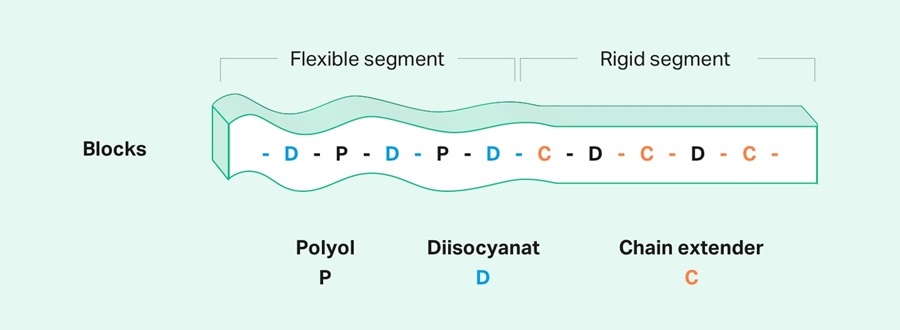Featured Brands
- Thermoplastic polyurethanes

A structured network of rigid and flexible segments
When the reaction between the chemical building blocks of TPU is controlled in a targeted manner, it is possible to achieve a bigger or smaller block structure, which is determined by the frequency (separation) of flexible polyol groups and rigid (ordered) chain extenders. This order in the chain-extender blocks happens due to a physical interaction with the chain-extender blocks of the neighboring polymer chain. These interactions constitute the nodes for the elastic behavior of TPU. At the same time, the reversibly melting nodes are a condition for the thermoplastic behavior of TPU.
The flexible polyol blocks then form the so-called “flexible segments” (shown as squiggles in the diagram) in three-dimensional macroscopic space, while the rigid chain extender blocks form what are called “rigid segments” (depicted as rods).
The rigid and flexible segments form what are called different morphological “phases”. It is the shape and distribution of these phases, which can also include mixed phases of both rigid and flexible segments, that are ultimately the primary determinants of the application properties of a TPU.
Tunable building blocks and processes
TPU is highly tunable, so it can be adjusted to meet the requirements of different applications and processing methods. One starting point for tuning is the chemical building blocks in TPU; the other is its production process. To start with the building blocks, the non-ordered flexible segments are responsible for the material’s chemical properties and for its resistance to hydrolysis, microbes and chemicals. The key characteristic of low-temperature flexibility can also be adjusted via the flexible segments. The ordered or “crystalline” rigid segments determine the processing characteristics of the TPU, such as melting and solidification behavior, as well as thermal properties such as the heat distortion temperature.
The material properties of TPU can similarly be influenced to a great extent through the production process, i.e. by the order and strength in which the basic raw materials are mixed and by the mixing temperature. The hardness can be varied over a broad range (44 Shore A to 85 Shore D) through the quantitative ratio of rigid segments to flexible segments, as can the moduli in mechanical tests (1 – 2000 MPa). The chain length of the TPU polymer is adjusted via the ratio of diisocyanate to the sum total of diols. TPU molecular weights of Mn 20,000 to 150,000 can be achieved. Additional characteristics such as melting behavior, heat deflection temperature and mechanical strength of a TPU can be influenced in a similar manner.



















